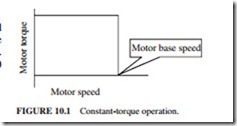BASIC PRINCIPLES OF AC VARIABLE-SPEED DRIVES
A variable-speed drive (VSD) is used to drive a motor at variable speed. The main parts of a VSD are
The control system of the VSD adjusts the output voltage and frequency so that the ratio of voltage to frequency remains constant at all times. The two modes of operation are as follows:
In this region, the motor increases in speed from zero to the rated base speed while the torque remains at the rated value (Fig. 10.1). The motor produces its maximum (rated) power at the base speed.
base speed (Fig. 10.2). The frequency of the VSD is increased and the flux is decreased while the armature voltage is kept at its rated value. Since the motor was at its maximum power at base speed, the torque must be reduced when the speed is increased (power torque X speed).
Related posts:
Limitations of Thermal Protective Devices
Audio Principles:Root Mean Square Measurements
SPLIT-PHASE MOTOR - POLYPHASE MOTOR STARTERS (Motor Starting Methods)
TESTING OF DC MACHINES
Conduit and Trunking Systems:Overview of Conduit Types
VARIABLE-SPEED DRIVES:TRANSIENTS, HARMONICS POWER FACTOR, AND FAILURES
Constant-Horsepower Connection
VARIABLE-SPEED DRIVES:CABLE DETAILS
State Variable Feedback Control Theory:Conclusion
PNEUMATIC CONTROL FUNDAMENTALS:NOZZLE-FLAPPER ASSEMBLY
SENSORS AND ACTUATORS:INDUSTRIAL MEASUREMENT SENSORS
AUDIO AND VIDEO SYSTEMS - PORTABLE STEREO
Troubleshooting and Repairing Computer Printers – Power supply service techniques
Testing and Measuring Instruments

